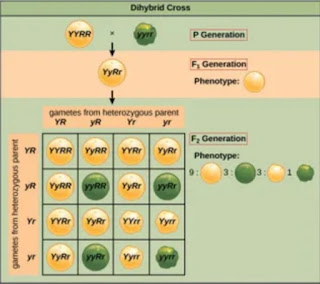Mendel law of inheritance
Mendel's law of inheritance:
It was during the mid-nineteenth century that headway was made In the
understanding of inheritance. Gregor Mendel, conducted hybridisation
experiments on garden peas for seven years (1856-1863) and proposed the law oy
inheritance in living organisms. During Mendel's investigations into
inheritance patterns it was for the time that statistical analysis and
mathematical logic were applied to problems in biology. His experiments had a
large sampling size, which gave Greater credibility to the data that he
collected. Also the confirmation of his inferences from experiments on
successive generation of his test plants, proved that his results pointed to
general rules of inheritance rather than being unsubstantiated ideas. Mendel
investigated characters in the garden pea plant that were manifested as two
opposing traits, e. g., tall and dwarf plants, yellow or green seeds. This
allowed him to set up a basic framework of rules govering inheritance, which
was expanded on by later scientists to account for all the diverse natural
observations and the complexity inherent in them. Mendel conducted such artificial pollination/cross pollination experiments using several true-breeding pea lines. A true-breeding lime is one that, having undergone continuous self-pollination, shows the stable trait inheritance and expression for several generations. Mendel selected 14 true-breeding pea Plant varieties, as pairs which were similar except for one character with contrasting traits. Some of the contrasting traits selected were smooth or wrinkled seeds, yellow or green seeds, smooth or inflated pods, green or yellow pods and tall or dwarf plants.
Monohybrid Cross:
In experiment, Mendel took two pea plants of opposite traits (one short and one tall) and crossed them. He found the first generation offsprings were tall and called it F1 progeny. Then he crossed F1 progeny and obtained both tall and short plants in the ratio 3:1. To know more about this experiment, visit Monohybrid Cross – Inheritance Of One Gene.
Mendel even conducted this experiment with other contrasting traits like green peas vs yellow peas, round vs wrinkled, etc. In all the cases, he found that results were similar. From this, he formulated the laws of Segregation And Dominance
Dihybrid Cross:
In a dihybrid cross experiment, Mendel considered two traits, each having two alleles. He crossed wrinkled-green seed and round-yellow seeds and observed that all the first generation progeny (F1 progeny) were round-yellow. This meant that dominant traits were the round shape and yellow colour.
He then self-pollinated the F1 progeny and obtained 4 different traits wrinkled-yellow, round-yellow, wrinkled-green seeds and round-green in the ratio 9:3:3:1.
Law of Dominance:
Law of independent assortment:
Also known as Mendel’s second law of inheritance, the law of independent assortment states that a pair of trait segregates independently from another pair during gamete formation. As the individual heredity factors assort independently, different traits get equal opportunity to occur together.
Law of segregation:
The law of segregation states that during the production of gametes, two copies of each hereditary factor segregate so that offspring acquire one factor from each parent. In other words, allele (alternative form of the gene) pairs segregate during the formation of gamete and re-unite randomly during fertilization. This is also known as Mendel’s third law of inheritance.
Contact us: gmail:motalemahesh7@gmail.com





Comments
Post a Comment